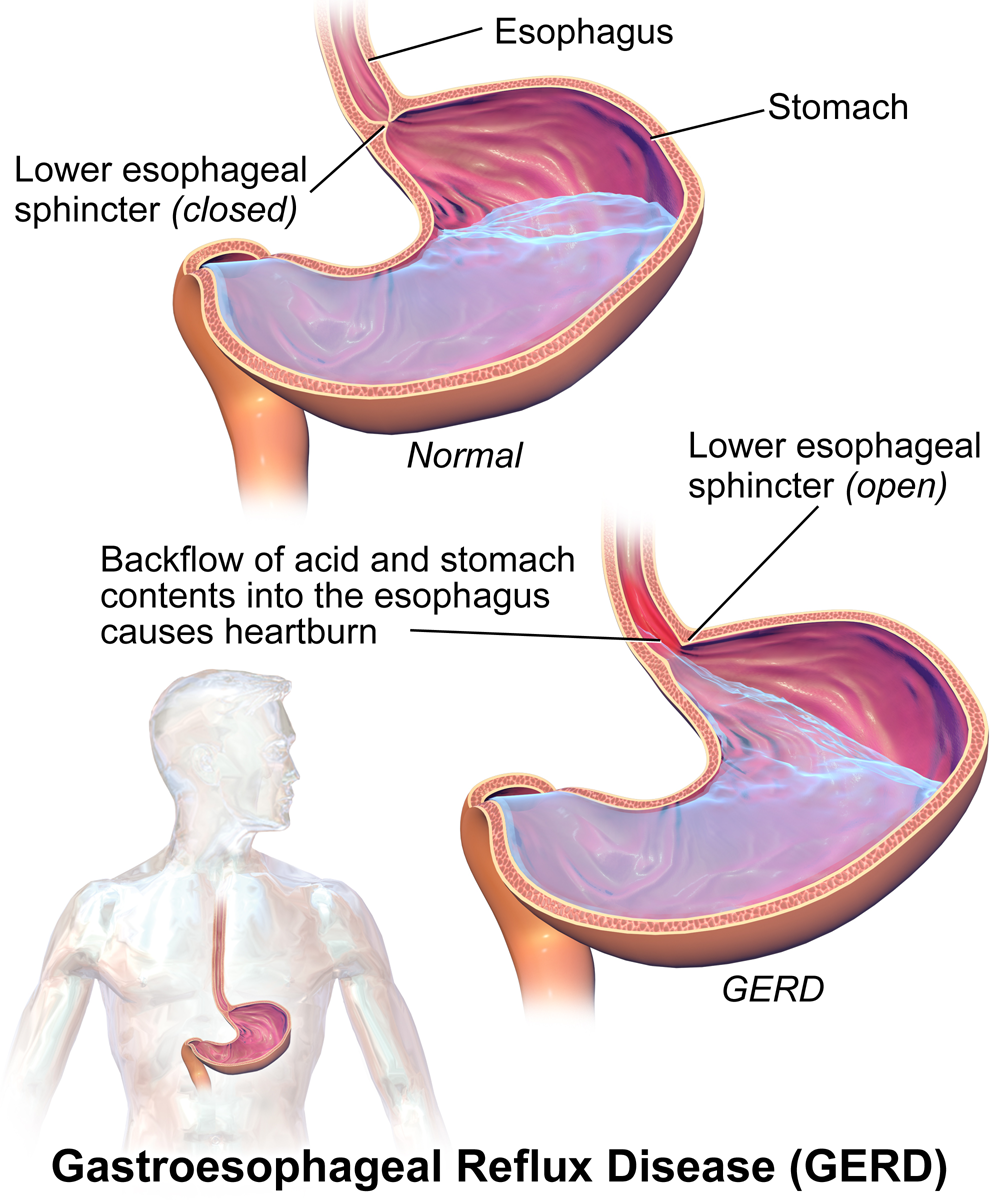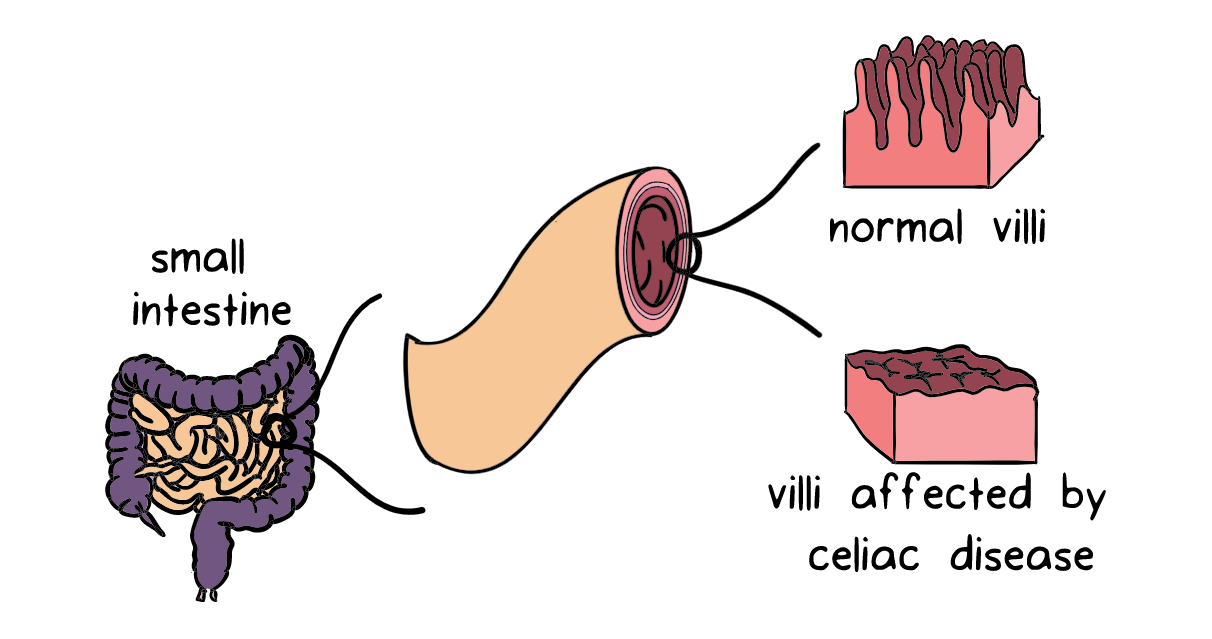3.4: Disorders That Can Compromise Health
- Page ID
- 48016
- Describe various disorders and diseases related to digestion.
When nutrients and energy are in short supply, cells, tissues, organs, and organ systems do not function properly. Unbalanced diets can cause diseases and, conversely, certain illnesses and diseases can cause an inadequate intake and absorption of nutrients, simulating the health consequences of an unbalanced diet. Overeating high-fat foods and nutrient-poor foods can lead to obesity and exacerbate the symptoms of gastroesophageal reflux disease (GERD) and irritable bowel syndrome (IBS). Many diseases and illnesses, such as celiac disease, interfere with the body getting its nutritional requirements. A host of other conditions and illnesses, such as food allergies, food intolerances, peptic ulcers, and Crohn’s disease can impair the process of digestion and/or negatively affect nutrient balance and decrease overall health.
Diarrhea
Diarrhea is defined as the frequent passage of loose, watery stools. 'Frequent passage' means more than three times in one day.
Contributing factors
Typical causes of diarrhea include:
- infection of the digestive tract
- stress
- certain foods/beverages
- reaction to medication
Treatment
If the diarrhea lasts for a long period of time, a person could become dehydrated if fluids and minerals are not replaced. Fluids and minerals can typically be replaced through normal food and beverage consumption. However, beverages that contain electrolytes (e.g., pedialyte, sports drinks) are also an option.
Constipation
Constipation is generally described as having fewer than 3 bowel movements in a week. In addition, the bowel movements tend to be small, hard, and difficult to pass.
Contributing factors
Factors that contribute to constipation can include:
- travel
- change in diet
- certain medications
Treatment
Common suggestions for relief of constipation include:
- increasing fluid intake
- increasing fiber intake
- regular exercise that incorporates leg movement (e.g., walking)
Gastroesophageal Reflux Disease
Gastroesophageal reflux disease (GERD) is a persistent form of acid reflux that occurs more than two times per week. Acid reflux occurs when the acidic contents of the stomach leak backward into the esophagus and cause irritation. In other words, it's a result of hydrochloric acid (HCl) flowing back up into the esophagus through an open or relaxed sphincter into the lower portion of the esophagus, burning the esophageal lining (Figure \(\PageIndex{1}\)). The pain is typically felt behind the sternum, over the heart, which is why the most common GERD symptom is called "heartburn". People with GERD may also experience regurgitation (flow of the stomach’s acidic contents into the mouth), frequent coughing, and trouble swallowing.

Contributing factors
The exact causes of GERD are unknown. However, some contributing factors include:
- overweight/obesity
- pregnancy
- cigarette smoking
- certain foods/beverages (e.g., spicy foods, chocolate, fried foods, tomato-based foods, caffeine, alcohol)
Treatment
The first approach to GERD treatment is dietary and lifestyle modifications. Suggestions are to reduce weight if you are overweight or obese, avoid foods that worsen symptoms, eat smaller meals, stop smoking, and remain upright for at least three hours after a meal. There is some evidence that sleeping on a bed with the head raised at least six inches helps lessen the symptoms of GERD.
Many medications are available to treat GERD, including antacids, histamine (H2) blockers, and proton-pump inhibitors. Some evidence from scientific studies indicates that medications used to treat GERD may accentuate certain nutrient deficiencies (e.g., Vitamin B12) in older populations.1 When these treatment approaches do not work, surgery is an option. The most common surgery involves reinforcing the sphincter that serves as a barrier between the stomach and esophagus.
Peptic Ulcer
A peptic ulcer is an area of the GI tract that have been eroded by a combination of HCl and the enzyme pepsin. A gastric ulcer is located in the stomach area. A duodenal ulcer is located in the duodenum, usually close to the stomach.
Contributing factors
Common causes of peptic ulcers include:
- The bacterium Helicobacter pylori (H. pylori) which can cause inflammation of the stomach's inner layer and lead to an ulcer
- Prolonged use of nonsteroidal anti-inflammatory drugs (NSAIDs) such as ibuprofen (Advil) and naproxen sodium (Aleve)
Treatment
Treatment of a peptic ulcer depends on the cause of the ulcer. Medications available include antibiotics to kill H. pylori or medications aimed at reducing or blocking acid production (e.g., proton pump inhibitors to reduce stomach acid production or histamine blockers to reduce the amount of stomach acid released).
Irritable Bowel Syndrome
Irritable bowel syndrome (IBS) is characterized by muscle spasms in the colon that result in abdominal pain, bloating, constipation, and/or diarrhea. Interestingly, IBS produces no permanent structural damage to the large intestine. The disorder is more prevalent in women than men. There is no specific test to diagnose IBS, but other conditions that have similar symptoms (such as celiac disease) must be ruled out. This involves stool tests, blood tests, and having a colonoscopy (which involves the insertion of a flexible tube with a tiny camera on the end through the anus so the doctor can see the colon tissues).
Contributing Factors
The precise cause of IBS isn't known, but factors that appear to play a role include:
- stress
- severe infections
- certain foods/beverages (e.g., wheat, dairy products, citrus fruits, beans, fatty foods, coffee, alcohol)
Treatment
As with GERD, the first treatment approaches for IBS are diet and lifestyle modifications. People with IBS are often told to keep a daily food journal to help identify and eliminate foods that cause the most problems. Other recommendations are to eat slower, add more fiber to the diet, drink more water, and/or consider following a low FODMAP diet.2 FODMAP stands for Fermentable Oligosaccharides, Disaccharides, Monosaccharides and Polyols; following a low FODMAP diet is highly recommended for people with IBS.
Celiac Disease
Celiac disease is an autoimmune disorder caused by an abnormal immune reaction of small intestine cells to a type of protein, called gluten (and specifically gliadin, which is a component of gluten). Gluten is found in grains that are commonly used to make bread, such as wheat, rye, and barley. For those who are sensitive to gluten, it is good to know that corn, millet, buckwheat, and oats do not contain the proteins that make gluten. However, some people who have celiac disease also may have a response to products containing oats. This is most likely the result of cross-contamination of grains during harvest, storage, packaging, and processing. While celiac disease is a serious illness, many people avoid gluten, but may not fully understand what gluten is, as seen in the following Jimmy Kimmel segment.
Symptoms can range from mild to severe and can include pale, fatty, loose stools, gastrointestinal upset, abdominal pain, weight loss and, in children, a failure to grow. The symptoms can appear in infancy or much later in life, even by age seventy. Celiac disease is not always diagnosed because the symptoms may be mild.
Celiac disease diagnosis requires a blood test and a biopsy of the small intestine. Because celiac disease is an autoimmune disease, antibodies produced by white blood cells circulate in the body and can be detected in the blood. When gluten-containing foods are consumed the antibodies attack cells lining the small intestine leading to a destruction of the small villi projections (see Figure \(\PageIndex{2}\)). This tissue damage can be detected with a biopsy, a procedure that removes a portion of tissue from the damaged organ. Villi destruction is what causes many of the symptoms of celiac disease. The destruction of the absorptive surface of the small intestine also results in the malabsorption of nutrients, so that while people with this disease may eat enough, nutrients do not make it to the bloodstream because absorption is reduced. Over time these nutrient deficiencies can cause health problems. Poor absorption of iron and folic acid can cause anemia, which is a decrease in red blood cells. Anemia impairs oxygen transport to all cells in the body. Calcium and vitamin D deficiences can lead to osteoporosis, a disease in which bones become brittle.

If you think you or someone close to you may have celiac disease, do not despair; it is a very treatable disease. Once diagnosed, a person follows a gluten-free diet for life. This requires dedication and careful detective work to seek out foods with hidden gluten, but many stores and restaurants carry gluten-free foods. After eliminating gluten from the diet, the tissues of the small intestine rapidly repair themselves and heal in less than six months.
Food Intolerances
A food intolerance is gastrointestinal discomfort caused by food; there is a physical reaction but no immune system reaction. One common food intolerance is lactose intolerance which is caused by the lack of the enzyme lactase. Lactase is produced in the small intestine and is used to break down the sugar in milk called lactose. Without the enzyme present to break down lactose, symptoms such as gas, bloating, cramping, and diarrhea occur. Food intolerances do not involve an immune system response which distinguishes them from food allergies.
Food Allergies
Unlike a food intolerance, when someone has a food allergy, there is an inflammatory reaction to food caused by an immune system reaction. The immune system mistakenly attacks a certain kind of food (usually the protein component of a food) as if it were a threat. Food allergy symptoms usually develop within a few minutes to two hours after a person has eaten a food to which they are allergic. These symptoms can range from the annoying to the potentially fatal, and include:
- A tingling mouth
- Swelling tongue and/or throat
- Difficulty breathing
- Hives
- Stomach cramps
- Diarrhea
- Vomiting
- Drop in blood pressure
- Loss of consciousness
- Death
There are no clear treatments for food allergies. Epinephrine is sometimes used to control severe reactions; individuals with known and dangerous allergies may get prescriptions for self-injectable devices. The only certain way to avoid allergic reactions to food is to avoid the foods that cause them. Beyond avoidance, this can mean reading food labels carefully, or even calling manufacturers for product information.
Most food allergies are caused by these nine foods:
- Milk
- Eggs
- Peanuts
- Tree nuts
- Fish
- Shellfish
- Wheat
- Soy
- Sesame
Key Takeaways
- Certain disorders and diseases can cause an inadequate intake and absorption of nutrients simulating the health consequences of an unbalanced diet.
References
- Heidelbaugh, JJ. Proton pump inhibitors and risk of vitamin and mineral deficiency: evidence and clinical implications. Ther Adv Drug Saf. 2013;4(3):125–133.
- Try a FODMAPs diet to manage irritable bowel syndrome. health.harvard.edu. https://www.health.harvard.edu/diet-and-weight-loss/a-new-diet-to-manage-irritable-bowel-syndrome. Updated September 17, 2019. Accessed June 9, 2020.

